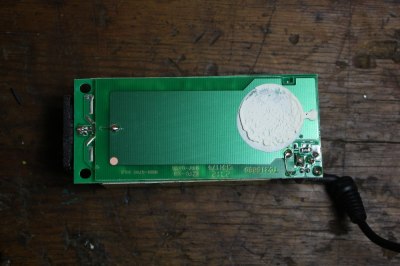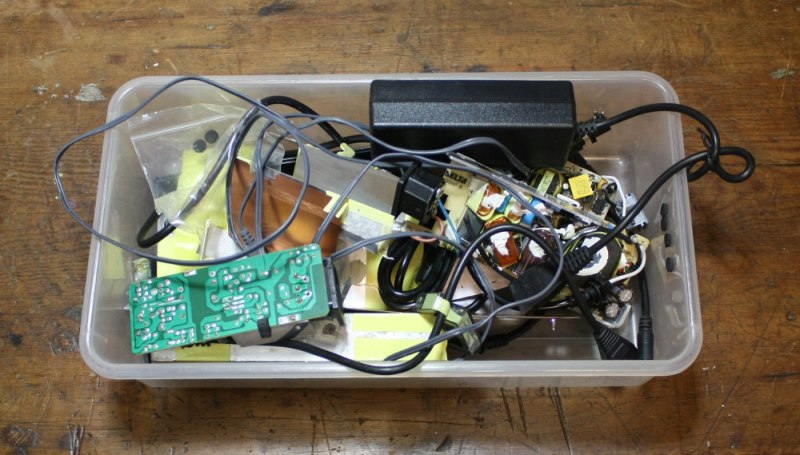We love a good tear-down, and last week’s “Enginursday” at Sparkfun satisfied our desire to see the insides of AC-DC switching power supplies, accompanied by knowledgeable commentary. [MTaylor] walks us through how the basic circuit works and then points out why various other elaborations are made, and how corners are sometimes cut, in a few power supplies that he’s taken apart.
 What struck us in the comparison was that some of the power supplies were very minimal designs, while others had “features” that were obviously added after the fact. For instance, the Li Shin supply (about half-way down the page) has an extra circuit board tacked on to the bottom of the real circuit board to act as EM shielding.
What struck us in the comparison was that some of the power supplies were very minimal designs, while others had “features” that were obviously added after the fact. For instance, the Li Shin supply (about half-way down the page) has an extra circuit board tacked on to the bottom of the real circuit board to act as EM shielding.
Rather than declare this a dodgy hack, as we would have, [MTaylor] declares it to be “Good News!” because it means that they’ve probably run an emissions test, failed it, and then added this bit on to make it pass. This is of course in contrast to the other makers who’ve probably never even considered emissions testing. Sigh.
If you’re interested in seeing more inner bits of power bricks, Sparkfun forum reader [sgrace] passed along this field guide to various power supplies, which is also worth a look. And if you’re interested in building yourself the ultimate bench power supply, look no further than this Hackaday.io project by [The Big One].
















Nice job! Since a Christmas tree light runs about 3-5 volts (depending on circuit) the batteries could be replaced by a diode and capacitor? and then plug it in place of one bulb on a string.
Oh great, Wrong article!
“This is our 12V/5V Power Supply. Judging from the comments, customers absolutely love this supply. Oh wait, I think I read that wrong. This supply is just $9.95. Looking at the engineering triangle, something else has to give.”
Wait, they haven’t done destructive testing on the things they sell? Just sling cheap Chinese junk, who cares about safety or EMC compliance? Jebus.
Sling cheap Chinese junk for marked up prices pretty much defines a lot of what SparkFun sells. Most often it doesn’t matter and their customer service is great, but these mains supplies are truly a disaster waiting to happen. I did comment to that effect under that video.
They seem to have learned their lesson and are “vetting” the supplies they are selling now, whatever that means. However, if the supply has a fake or no FCC or CE markings and someone gets hurt, that vetting is going to help them little – they are going to be in a world of hurt.
The same with the cheapo multimeters they were importing (and got them originally confiscated by Fluke) – https://www.sparkfun.com/products/12966 (teardown and discussion here: http://www.eevblog.com/forum/testgear/sparkfun-multimeter-teardown/)
While these are OK for measuring stuff around an Arduino or something similar, they are not safe. They have an indication of a CAT III rating – needs to be able to withstand 6kV, since it is rated up to 600V (!). I only hope nobody actually pokes the probes of this thing anywhere near a mains socket. There is no blast protection inside, glass not HRC fuses (thus doesn’t meet the CAT III rating right there), etc. It is certainly better than some other cheapies, but that fake CAT III rating is asking for a lawsuit (and injury …) if someone actually happens to take it seriously out of ignorance. People have died because of glass fuses in cheapo meters with fake ratings before.
Are there multimeters out there that actually live up to their CAT ratings, that aren’t missing ranges such a uA and mA that don’t break your wallet?
Depends how big your wallet is and how hard it is to break. I am a big fan of my Amprobe AM-140 which has features of some seriously high end models and is under the same parent company as fluke.
If I hear one more powersupply emit a high pitch brain crushing whine sound… i’m gona puke.
This teardown of a Macbook power supply reveals a much more complex design that might justify the price tag: http://www.righto.com/2015/11/macbook-charger-teardown-surprising.html
As a hamradio operator, I have chased down multiple “Wall warts” in my own home, acting as a broad band jammer device, wors was probably the wallwart to my router (brand name, expensive one) that leaked RFI out on my CAT5 cables that acted as antennas.
Other favourites are cheap cristmas LED strings, also using the cable as antenna, and almost every phonecharger ever.
snap on ferrite cores work great for supressing all that. I buy them like candy and pop them on everything.
I have my fair share of those too, but they shouldn’t be needed.
Sigh, I feel your pain :-).
Living in an apartment building with ancient rg-59 leaking cable signals like a sieve and at least 34 separate APs and god knows how many devices accessing them, makes HF so chancy as to be a write off, even up to VHF at times.
S9+ noise and a rolling buzz saw up and down the bands (cable?) are the joys of all this cost reduced by idiots to where removing one more component wouldn’t let devices work at all…
Atleast, I’m living by myself, with my closest neighbour 2-300meters away, I can just unplug my own stuff, and then It’s nice and quiet.
Or else I just take my QRP rig to somewhere quiet.
But for you, I would recomend a remote controlled radio, if you get one of the models with separate frontpanel, it still feels like you have the radio in your home.
Then you just need to find a quiet place with internet where you can place the radio and antennas.
Check out http://www.remoterig.com/wp/
The guy writing the article is kind of not so knowledgeable about the subject….
“Also, sometimes I refer to the primary side components as the “high side” and secondary as “low side.”” — high side and low side mean some totally different things. He should use primary and secondary side.
” This supply uses two 200V caps in series, but I don’t understand how it works yet. There is a 115-230V selector switch for line voltage that plays with the bridge.” — come on, this type of circuit is being used for ages!
That selector switch also has caused countless people to blow them up when they selected 110V but plugged it into 220V :D
Yep, you have no idea how many times I have heard “you know electronics, can you change the fuse on my PC supply, i put it on 110V accidentally”. Sad thing is….most of the times the fuse is not the only blown up thing in there.
Happened to my friend at work once. In the shop, you forget that some outlets are 220 instead of the standard 110 in the office. Capacitor innards coated the entire inside of the supply.
The plugs weren’t marked (at the least, a different color)? That’s a serious (code violation?) design oversight in the electrical of that building.
I once worked in a server room where all the racks ran on 208V. The power connectors from the “power strips” to the devices being powered are just ordinary IEC connectors, identical to the ones used on common 120V equipment. I have heard that back before universal voltage supplies were common, new IT techs often assumed “a power socket is a power socket” and blew up stuff. Oh, and those “bootleg” IEC to standard 120V adapters no doubt made for some exciting times…
A number of years ago, I worked at a company where (during a holiday shutdown) an electrician accidentally hooked up one of the other “hot” legs instead of neutral for much of a building. 110V was suddenly 208V, and pretty much every pc needed a new power supply. Most of the workstations and monitors auto-switched (fortunately).
I remember tables of dead power supplies at the company surplus store, providing a cheap source of fans.